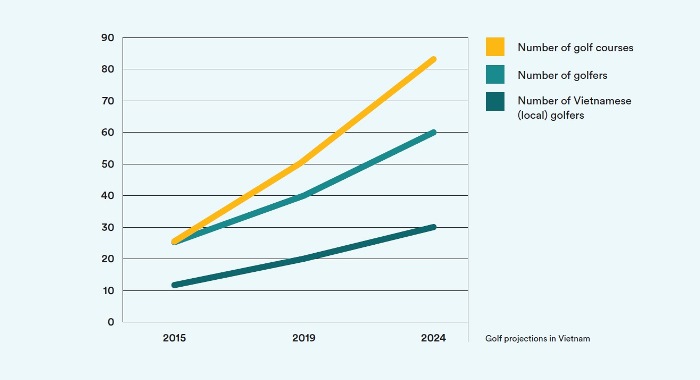Is Vietnam’s golf industry really “booming”?
By Robert Bicknell

That’s not a “boom” to me, but rather an act of cannibalism.
Here’s the situation – if you have a pitcher of water and two people, each will get enough to drink. But with every added person, each gets less. As the amount of people increases, the pitcher will get drained more, but if it’s not refilled often or quickly enough, or if the amount of people drinking from the pitcher continues to grow, the people will dehydrate and die.
This is called “The Law of Diminishing Returns.” Now substitute “players” for water and “golf courses” for people and you’ll see immediately where the problem lies.
Vietnam currently has 51 golf courses and an estimated 40,000 players. In 2015, there were about 25,000 players. Unfortunately, the amount of Vietnamese (local) golfers is only around 50% max.
The projections are for 65 new golf course projects, with 25-30 opening within five years.

If the amount of golf courses increases faster than the amount of new players, you will begin to see golf clubs closing their doors as they become too expensive to operate and maintain.
This is called “Killing the Golden Goose” and it seems painfully obvious that Vietnam failed to learn a lesson from Thailand or the US, despite the government claiming it would limit the amount of new golf courses until it could show a demand for new ones.
We are already seeing the beginning stages of evolution as clubs shift from their previous status of “semi-private” (READ: Is a member club, but open to the public) to “public” (READ: Nobody wants to buy memberships with the amount of cheap golf out there).
In the late 1980s, Thailand started going golf crazy and developers built courses everywhere. Today, only 20% of those courses are making enough money to be considered “viable,” while the rest are begging for rounds.
When the “Tiger Boom” hit the US, people rushed out to learn how to play golf and developers rushed out to build more golf courses. Sadly, the boom didn’t last very long and, worse, Millennials don’t like golf - so courses are closing left and right.
According to the US National Golf Foundation, around 205 courses in the US closed in 2018, bringing the total of operating courses down to around 14,800 and this trend shows no signs of letting up, which means golf course architects and contractors are looking for fertile ground elsewhere.
Such as here in Vietnam.
Greed seems to be hardwired into the human brain and it seems we always want more, even if we don’t need it.
So, people see the current golf courses in Vietnam making money and decide to jump on the bandwagon. Designers cannot wait to rush in and offer world-class designs, builders follow in their wake, as do equipment manufacturers and all of them tout the importance of building now.
Sure, they have their own businesses to run and need to keep designing and building more courses to stay viable themselves. But, what happens to the courses after they get paid isn’t their problem.
Developers in Vietnam have a terrible habit of not performing due diligence and examining the market closely enough. They just figure they’ll open a course and people will leave wherever they are now to go to the new course, and this is true to a point. Either the players will get tired of it and go somewhere else, or another new course will open up and the cycle starts again, except there are even more courses trying to draw from the same basket of players.
Unless the amount of NEW players increases proportionally to the amount of new courses, we will begin to see closures within a few years as owners realize they are losing money simply by staying open.
What Vietnam needs more than new courses at this point in time are:
- Golf academies and schools which attract new players to the game (NOTE: I’d rather see a few World Class Greg Norman Golf Academies with full scholarships for poor kids who show potential than 20 new courses. But, 10 new Shark courses would keep me happy).
- More junior golf programs, especially in schools, and lower rates for juniors.
- Lower taxes so clubs can remain economically viable.
- Stricter enforcement of Environmental Protection Laws.
As someone who actually helped start the golf business here in Vietnam in 1992, I want to see the game continue to grow and remain sustainable for a long time. But to do that, intelligent plans and a roadmap must be made now, not later.













